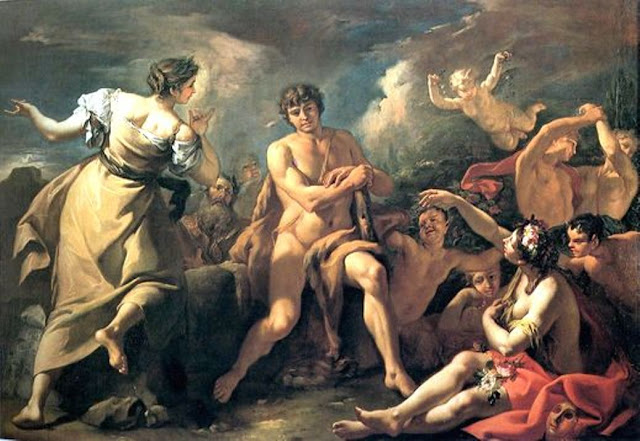Sebastiano Ricci's
Italian Painter
1659 AD - 1734 AD
Sebastiano Ricci (1 August 1659 – 15 May 1734) was an Italian painter of the late Baroque school of Venice. About the same age as Piazzetta, and an elder contemporary of Tiepolo, he represents a late version of the vigorous and luminous Cortonesque style of grand manner fresco painting.
He was born in Belluno, son of Andreana and Livio Ricci. In 1671, he apprenticed to Federico Cerebri of Venice. Others claim Ricci’s first master was Sebastiano Mazzoni. In 1678, a youthful indiscretion led to an unwanted pregnancy, and ultimately to a greater scandal, when Ricci was accused of attempting to poison the young pregnant woman to avoid marriage. Imprisoned, he gained release only after intervention of a nobleman, probably a Pisani family member. He married the pregnant mother in 1691, although this was a stormy union.
After his arrest, he moved to Bologna, where he domiciled near the Parish of San Michele del Mercato. His painting style there was apparently influenced by Giovanni Gioseffo dal Sole. On 28 September 1682 he was contracted by the "Fraternity of Saint John of Florence" to paint a Decapitation of John the Baptist for their Oratory. On 9 December 1685, the Count of San Segundo near Parma commissioned from Ricci the decoration of the Oratory of the Madonna of the Seraglio, which he completed in collaboration of Ferdinando Galli-Bibiena by October 1687, receiving a compensation of 4,482 Lira. In 1686, the Duke Ranuccio II Farnese of Parma commissioned s Pietà for a new Capuchin convent. From 1687-1688, the apartments of the Parmense Duchess in Piacenza were decorated by Ricci with canvases recalling the life of the Farnese pope
Apparently in 1688, Ricci abandoned his wife and daughter, and fled from Bologna to Turin with Magdalen, the daughter of the painter Giovanni Peruzzini. He was again imprisoned, and nearly executed, but ultimately was freed by the intercession of the Duke of Parma. The duke employed him and assigned him a monthly salary of 25 crowns and lodging in the Farnese palace in Rome. In 1692, he was commissioned to copy the Coronation of Charlemagne by Raphael in Vatican City, on behalf of Louis XIV, a task he finished only by 1694. The death of the Duke Ranuccio in December, 1694, who was also his protector, forced Ricci to abandon Rome for Milan, where by November of 1695 he completed frescoes in the Ossuary Chapel of the Church of San Bernardino dei Morti. On 22 June 1697, the Count Giacomo Durini hired him to paint in the Cathedral of Monza.
In 1698, he returned to the Venetian republic for a decade. By 24 August 1700, he frescoed the chapel of the Santissimo Sacramento in the church of Santa Giustina of Padua. In 1701, the Venetian geographer Vincenzo Maria Coronelli commissioned a canvas of the Ascension that was inserted on the ceiling of sacristy of the Basilica of the Santi Apostoli in Rome. In 1702, he frescoed the ceiling of the Blue Hall in the Schönbrunn Palace, with the Allegory of the Princely Virtues and Love of Virtue, that illustrated the education and dedication of future emperor Joseph I. In Vienna, Frederick August II, the elector Saxony, requested an Ascension canvas, in part to convince others of the sincerity of his conversion to Catholicism, which allowed him to become the King of Poland. In 1704 he executed in Venice a canvas of San Procolo (Saint Proculus) for the Dome of Bergamo and a Crucifixion for the Florentine church of S. Francisco de Macci.
From Wikipedia





































































